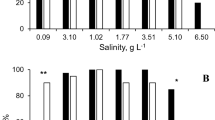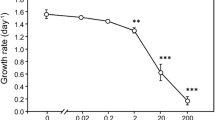Abstract
In aquatic environments, predator kairomones have been shown to affect morphology of prey species. Past work on the interaction between zooplankton and phytoplankton was based mainly on the Daphnia–Scenedesmus model. Algae of the genus Staurastrum can produce mucilage, causing cell clumping and settling out of the water column. These clumps are too large to be eaten by daphniids. Thus, we hypothesised that this may be a grazer defence. We investigated whether Daphnia magna induces the formation of mucus globules in Staurastrum, how this occurs, and if the formation of clumps inhibits growth in juvenile Daphnia. Eight strains of Staurastrum were used to check whether mucus extrusion is induced by the presence of Daphniaor possibly by a chemical excreted by Daphnia magna. None of the strains reacted to the presence of Daphnia water alone, animals had to be present to induce clumping. Mechanical action (gentle stirring) caused the same strains to clump. The ecological relevance of clumping was then investigated. The different Staurastrum strains were used as food in a growth experiment with ecologically relevant densities of neonates of Daphnia hyalina. These small daphniids did not cause the same clumping observed for Daphnia magna when present in experiments at high densities. We observed that juvenile daphniids grew less well on strains with larger cell size.
Similar content being viewed by others
References
Boeing, W. J., A. Wagner, H. Voigt, T. Deppe & J. Benndorf, 1998. Phytoplankton responses to grazing by Daphnia galeata in the biomanipulated Bautzen reservoir. Hydrobiologia 398: 101-114.
Coesel, P. F. M., 1997. The edibility of Staurastrum chaetoceras and Cosmarium abbreviatum (desmidiaceae) for Daphnia galeata/hyalina and the role of desmids in the aquatic foodweb. Aquat. Ecol. 31: 73-78.
Fukami K., S. Ohara & Y. Ishida, 1990. Effect of extracellular organic carbon from phytoplankton on the community structure of oligotrophic bacteria. Arch. Hydrobiol. Beih. Ergebn. Limnol. 34: 43-48.
Gliwicz, Z. M., P. Dawidowicz, A. Jachner & W. Lampert, 2001. Roach habitat shifts and foraging modified by alarm substance - 2. Reasons for different responses of fish in field and laboratory studies. Arch. Hydrobiol. 150: 377-392.
Hansson L. A. & L. J. Tranvik, 1996. Quantification of invertebrate predation and herbivory in food chains of low complexity. Oecologia 108: 542-551.
Harvell, C. D., 1990. The ecology and evolution of inducible defenses. Quart. Rev. Biol. 65: 323-340.
Havel, J. E., 1987. Predator-induced defenses: a review. In Kerfoot, W. C. & A. Sih (eds), Predation: Direct and Indirect Impacts on Aquatic Communities. University Press, New England, Hanover: 263-278.
Hessen, D. O. & E. van Donk, 1993. Morphological changes in Scenedesmus induced by substances released from Daphnia. Arch. Hydrobiol. 127: 129-140.
Kusch, J., 1993. Induction of defensive morphological changes in ciliates. Oecologia 94: 571-575.
Lampert, W., K. O. Rothhaupt & E. von Elert, 1994. Chemical induction of colony formation in a green alga (Scenedesmus acutus) by grazers (Daphnia). Limnol. Oceanogr. 39: 1543-1550.
Larsson, P. & S. I. Dodson, 1993. Chemical communication in planktonic animals. Arch. Hydrobiol. 129: 129-155.
Lass, S. & P. Spaak, 2003. Chemically induced anti-predator defences in plankton: a review. Hydrobiologia 491: 221-239.
Lüning, J., 1995. Life-history responses to Chaoborus of spined and unspined Daphnia pulex. J. Plankton Res. 17: 71-84.
Lürling, M., 1999a. Grazer-induced coenobial formation in clonal cultures of Scenendesmus obliquus (Chlorococcales, Chlorophyceae). J. Phycol. 35: 19-23.
Lürling, M., 1999b. The smell of water; Grazer-induced colony formation in Scenedesmus. Ph.D., Agricultural University, Wageningen: 270 pp.
Lürling, M. & E. van Donk, 1996. Zooplankton-induced unicellcolony transformation in Scenedesmus acutus and its effect on growth of herbivore Daphnia. Oecologia 108: 432-437.
Nilsson, P. A., C. Brönmark & L. B. Pettersson, 1995. Benefits of a predator-induced morphology in crucian carp. Oecologia 104: 291-296.
Porter, K. G., 1976. Enhancement of algal growth and productivity by grazing zooplankton. Science 192: 1332-1334.
Reede, T., 1995. Life history shifts in response to different levels of fish kairomones in Daphnia. J. Plankton Res. 17: 1661-1667.
Rengefors, K., I. Karlsson & L. A. Hansson, 1998. Algal cyst dormancy: a temporal escape from herbivory. Proc. R. Soc. Lond. Ser. B 265: 1353-1358.
Scharf, W., 1995. Staurastrum quadridentatum spec.nov. (chlorophyta, Desmidiaceae): A new desmid species from the plankton. Arch. Hydrobiol. Suppl. 109: 1-10.
Stemberger, R. S. & J. J. Gilbert, 1987. Defenses of planktonic rotifers against predators. In Kerfoot, W. C. & A. Sih (eds), Predation: Direct and Indirect Impacts on Aquatic Communities. University Press, New England, Hanover: 227-239.
Stibor, H., 1992. Predator-induced life-history shifts in a freshwater cladoceran. Oecologia 92: 162-165.
Smetacek, V., 2001. A watery arms race. Nature 411: 745.
Surek, B., 1983. Mucilage regeneration in the green alga Cosmocladium saxonicum de Bary (Desmidiaceae): A light microscopic and quantitative study. Brit. Phycol. J. 18: 73-81.
Surek, B. & P. von Sengbusch, 1981. The localisation of Galactosyl residues and Lectin receptors in the mucilage and cell walls of Cosmocladium saxonicum (Desmidiaceae) by means of fluorescent probes. Protoplasma 108: 149-161.
Tollrian, R., 1995. Predator-induced morphological defenses: costs, life history shifts, and maternal effects in Daphnia pulex. Ecology 76: 1691-1705.
Tollrian, R. & C. D. Harvell (ed.). 1999. The Evolution of Inducible Defenses. Princeton University Press, Princeton.
van Holthoon, F. L., T. A. van Beek, M. Lürling, E. van Donk & A. de Groot, 2003. Colony formation in Scenedesmus: a literature overview and further steps towards the chemical characterisation of the Daphnia kairomone. Hydrobiologia 491: 241-254.
von Elert, E. & A. Franck, 1999. Colony formation in Scenedesmus: grazer-mediated release and chemical features of the infochemical. J. Plankton Res. 21: 789-804.
Wiltshire, K. H. & W. Lampert, 1999. Urea excretion by Daphnia: A colony-inducing factor in Scenedesmus? Limnol. Oceanogr. 44: 1894-1903.
Author information
Authors and Affiliations
Rights and permissions
About this article
Cite this article
Wiltshire, K., Boersma, M. & Meyer, B. Grazer-induced changes in the desmid Staurastrum . Hydrobiologia 491, 255–260 (2003). https://doi.org/10.1023/A:1024474827107
Issue Date:
DOI: https://doi.org/10.1023/A:1024474827107




